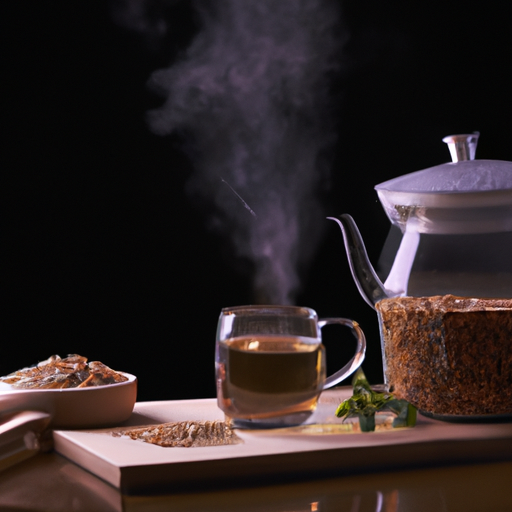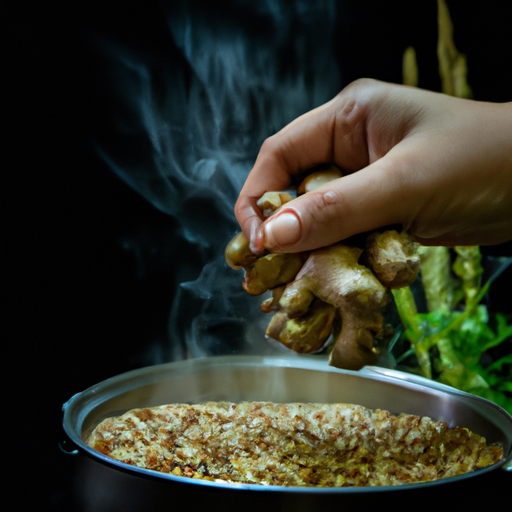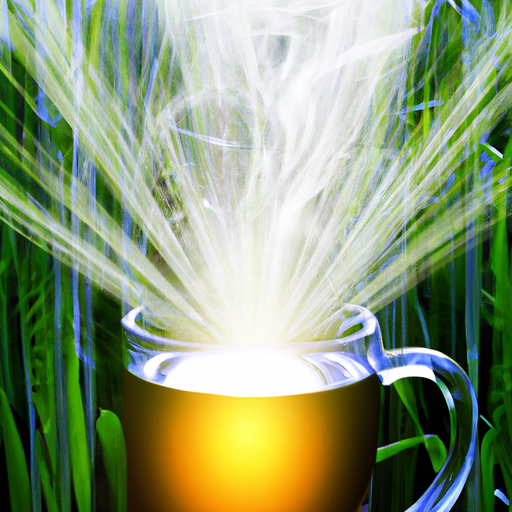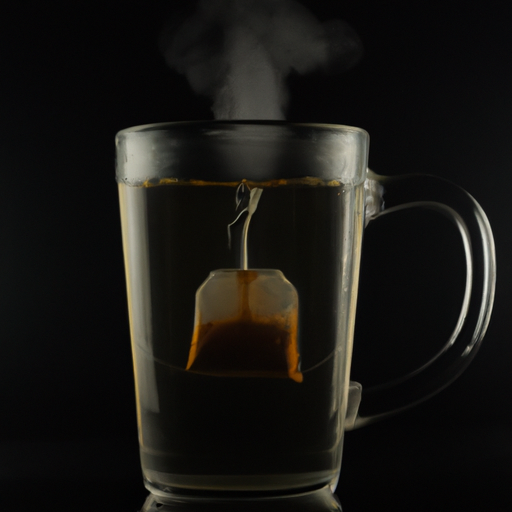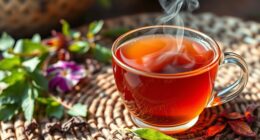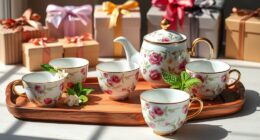Ever found yourself yearning for a rejuvenating, caffeine-free beverage that satisfies your thirst while also offering a plethora of health advantages? If that’s the case, I strongly suggest giving barley tea a try.
As someone who has been drinking barley tea for years, I can attest to its delicious taste and the positive impact it has had on my overall well-being. Barley tea, also known as mugicha, is a popular Japanese drink made from roasted barley grains. It has a nutty, slightly sweet taste and is often consumed hot or cold, depending on the weather.
Not only is it a delicious alternative to other beverages, but it also has numerous health benefits, such as aiding digestion, reducing stress, and even helping to lower cholesterol levels. In this article, I will guide you through the process of making your own barley tea at home, so you can experience its many benefits for yourself.
Key Takeaways
- Barley tea is caffeine-free and has many health benefits such as aiding digestion, reducing stress, and promoting regular bowel movements.
- To make barley tea, choose whole grains free of debris, roast them before steeping, and boil water at 200°F for 5-10 minutes before straining and serving hot or cold.
- Barley tea can be stored in an airtight container in the refrigerator or freezer and can be sweetened or served with cream. It can also be enjoyed with a variety of foods.
- Sharing barley tea is a great way to introduce new flavors and cultural significance, whether by hosting a tea party, gifting a homemade blend, or incorporating it into meals.
Benefits of Barley Tea
Barley tea has many benefits, including improving digestion and reducing inflammation. It’s a great way to incorporate a healthy beverage into your daily routine. Plus, it’s a natural diuretic that can help with weight loss by flushing out excess water weight. Additionally, it contains antioxidants that can help reduce inflammation in the body.
One of the ways barley tea can improve digestion is by relieving constipation. The fiber in barley helps promote regular bowel movements. Also, the tea can reduce stomach discomfort and bloating because it contains compounds that can relax the muscles in the digestive tract.
Overall, barley tea is a great choice for anyone looking to improve their digestive health. It’s a tasty and refreshing beverage that can be enjoyed hot or cold. So, now that you know about the benefits, let’s move on to gathering the ingredients to make your own barley tea.
Gather Ingredients
To make barley tea, I first gather the necessary ingredients: barley grains, water, and any optional ingredients I may want to add for flavor.
The barley grains can be found at most health food stores and are essential for creating the base of the tea. I make sure to use filtered water for the best taste and also consider adding ingredients like honey or lemon to enhance the flavor.
Barley Grains
As you’re sorting through your grains, you’ll want to keep an eye out for any broken pieces or stones that may have snuck in.
Barley grains are an excellent source of nutrition, containing fiber, protein, and several vitamins and minerals. They have been used in culinary dishes for centuries, including soups, stews, and salads. Barley grains can also be ground into flour for baking bread or used to make beer and whiskey.
When selecting barley grains for your tea, it’s important to choose whole grains that are free of debris. To enhance the flavor and aroma of your tea, consider roasting the grains in a dry skillet before steeping. This will bring out the nutty, toasty flavor of the barley.
As you move on to the next step of the process, it’s important to remember that the quality of the water used in your tea will also play a crucial role in the final result.
Water
When you’re brewing your beverage, you’ll want to make sure the water you use is of high quality to ensure a great taste. Before starting, I always check my water filtration system to ensure it’s working properly. This guarantees that any impurities are removed from the water, resulting in a clean and refreshing taste.
Additionally, it’s important to make sure you’re properly hydrated before brewing your barley tea. Drinking water throughout the day not only keeps you hydrated but also prepares your body for the brewing process. Hydration tips include drinking at least 8 glasses of water per day, avoiding sugary drinks, and incorporating fruits and vegetables with high water content into your diet.
With these tips in mind, you’re ready to move on to the next step of adding optional ingredients to enhance the flavor of your barley tea.
Optional Ingredients
You can really elevate the taste of your barley tea by experimenting with different flavors and brewing methods. For example, you can add lemon slices or mint leaves to give your tea a refreshing twist. If you prefer a more floral taste, try adding lavender or chamomile. You can also brew your tea with spices like cinnamon or ginger for a warm, cozy feel.
Another way to add more depth to your barley tea is to change up your brewing method. Instead of just steeping the barley in hot water, try roasting the grains first for a richer, nuttier flavor. You can also cold-brew your tea overnight in the fridge for a smoother, less bitter taste.
By experimenting with different ingredients and brewing techniques, you can create a unique and delicious cup of barley tea that suits your taste preferences perfectly.
Now let’s move on to the next step of roasting the barley grains.
Roasting Barley Grains
To get that perfect nutty flavor in your barley tea, start by roasting the grains in a pan until they’re golden brown and smelling like a million bucks. Roasting techniques vary depending on your preference, but I like to use a dry pan over medium heat and stir constantly to prevent any burning. It usually takes about 10-15 minutes to get the desired color and flavor profile.
Here are some tips to ensure your barley grains are roasted to perfection:
- Use fresh barley grains for the best flavor.
- Don’t overcrowd the pan to ensure even roasting.
- Watch the grains closely to prevent burning.
- Let them cool completely before brewing to prevent the tea from becoming bitter.
Now that your barley grains are roasted and ready to go, it’s time to move on to the next step: boiling water.
Boiling Water
Let’s talk about how boiling water is crucial for creating the perfect cup of barley tea. The best temperature for boiling water for barley tea is around 200°F. Water that’s too hot can scorch the tea leaves, while water that’s too cool may not release enough flavor. It’s important to bring the water to a full boil and then let it cool for a few seconds before pouring it over the roasted barley grains.
One common mistake when boiling water for barley tea is not using enough water. Properly steeping barley tea requires a high ratio of water to tea leaves. When the water to tea ratio is too low, the tea may become too strong and bitter.
Another mistake is not using filtered water. Tap water can contain impurities that affect the taste of the tea.
Now that we have the boiling water, it’s time to move on to the next step of steeping barley tea. By letting the water and roasted barley grains steep together, we can create a flavorful and refreshing cup of tea.
Steeping Barley Tea
So now that I’ve boiled the water, it’s time to start steeping the barley tea. First, I add the roasted barley grains to the pot of boiling water and let them steep for around 5-10 minutes, depending on how strong I want the tea to be.
After the tea has steeped to my liking, I strain it to remove the barley grains and pour the tea into a cup.
Adding Roasted Barley Grains to Boiling Water
First, add the roasted barley grains to the boiling water and let them steep for 5-10 minutes. The amount of barley you use will depend on how strong you want your tea to be. Adding more barley will create a rich, nutty flavor, while using less will give you a lighter, more subtle taste.
You can also experiment with different brewing techniques to achieve different flavor variations. For example, you can try simmering the barley in water for a longer period of time to bring out a deeper, fuller flavor. Alternatively, you can roast the barley before steeping it to give it a smoky, toasty taste.
Once the barley has steeped for the desired amount of time, strain the tea and discard the grains. At this point, you can either enjoy the tea hot or let it cool and serve it over ice.
In the next section, we’ll discuss the importance of allowing the tea to steep properly to get the most out of its flavor.
Allowing the Tea to Steep
After adding the roasted barley grains to boiling water, the next step in making barley tea is allowing the tea to steep. Steeping is a crucial process as it determines the taste and strength of the tea.
To ensure that the tea is perfectly steeped, I use various steeping techniques and temperature control methods. Firstly, I cover the pot with a lid and let the tea steep for about 5-10 minutes. During this time, I make sure that the temperature of the tea remains constant, as fluctuating temperatures can affect the taste.
Secondly, I occasionally stir the tea while it steeps to ensure that the barley grains are evenly distributed. Thirdly, I adjust the steeping time according to my preference. If I want a stronger tea, I let it steep for a longer time, and if I want a milder tea, I reduce the steeping time. Lastly, I sometimes add other ingredients such as ginger or honey to enhance the taste.
Now that the tea has been steeped to perfection, the next step is to strain it. Straining is essential as it removes any unwanted particles and ensures that the tea is smooth and clear.
Straining the Tea
Don’t let any unwanted particles ruin your delicious brew – strain it carefully! Once you’ve allowed the barley tea to steep for the desired amount of time, it’s time to strain out the grains.
There are several straining techniques and infusion methods that you can use to ensure that your tea is smooth and free of any debris. One popular method is to use a fine mesh strainer or a cheesecloth. Simply pour the tea through the strainer or wrap the cheesecloth around the mouth of your teapot before pouring. This will catch any loose grains or sediment that may have made it into your brew.
Another method is to use a French press, which allows you to press the grains down and separate them from the liquid. Whatever method you choose, make sure to strain the tea thoroughly for the best results.
With your strained barley tea ready, it’s time to move on to serving.
Serving Barley Tea
To serve your refreshing barley tea, grab a tall glass filled with ice and pour in the chilled tea until it reaches the brim, then garnish with a sprig of fresh mint. Presentation tips are important, as they can make the difference between a mediocre and a memorable drink. To make your barley tea even more appealing, consider using a clear glass that allows you to showcase the beautiful amber color of the tea. You can also add some sliced lemon or orange to the glass, or use a pretty straw to make it look more inviting.
Serving suggestions for barley tea are varied and can depend on your preferences. Some people enjoy drinking it plain, while others prefer it sweetened with honey or sugar. You can also add some milk or cream to make it creamier and richer, or experiment with different herbs and spices to give it a unique flavor. Whatever your choice, make sure to serve it chilled for maximum refreshment.
When you’re done enjoying your delicious barley tea, it’s important to store it properly to ensure it stays fresh and flavorful. Without writing ‘step’, the next section will cover how to store barley tea.
Storing Barley Tea
Hey, you want to make sure that your refreshing barley tea stays fresh and tasty, so it’s important to store it properly. Proper storage is key to maintaining the flavor and quality of your drink.
The best way to store barley tea is to keep it in an airtight container in the refrigerator. Barley tea has a shelf life of about two to three days when stored in the refrigerator. This means that it should be consumed within that time frame to ensure its freshness.
If you have leftover tea, it’s important to store it properly to avoid spoilage and ensure that it stays fresh and flavorful. To extend the shelf life of barley tea, you can freeze it. Simply pour the tea into an ice cube tray and freeze it.
Once the cubes are frozen, transfer them to a resealable plastic bag and store them in the freezer. This is a great option for those who want to enjoy barley tea all year round.
Now that you know how to store your barley tea, let’s move on to exploring the different variations of this delicious drink.
Variations of Barley Tea
Get ready to explore the delicious and unique ways to enjoy this refreshing beverage with some exciting variations of the classic barley tea. Barley tea variations can be divided into two main categories: sweet vs. salty and hot vs. cold.
Sweet barley tea is made by adding honey or sugar to the tea. It’s perfect for those who have a sweet tooth. On the other hand, salty barley tea is made by adding salt or soy sauce to the tea. It may sound unconventional, but it’s a popular choice in some Asian countries.
Another way to enjoy barley tea is to serve it hot or cold. Hot barley tea is perfect for cold winter days, while cold barley tea is an excellent thirst quencher during hot summer days. The cold version is also a great alternative to sugary drinks and soda.
In addition, barley tea can be paired with food to enhance the overall dining experience. It pairs well with sushi, grilled fish, and Korean BBQ. Barley tea is a versatile beverage that can be enjoyed in various ways. Whether you prefer sweet or salty, hot or cold, there is a barley tea variation that suits your taste.
Additionally, pairing barley tea with food is an excellent way to elevate the flavors of your meal. In the next section, we’ll explore the health benefits of barley tea.
Health Benefits of Barley Tea
I absolutely love barley tea, and I enjoy it anytime of the day, whether it’s hot or cold.
Not only is it a delicious and refreshing drink, but it also has numerous health benefits.
Trying different variations of barley tea is a great way to mix things up and find your favorite recipe.
I often share my love for barley tea with friends and family and always recommend it as a healthy and tasty alternative to other beverages.
Enjoying Barley Tea Anytime
Indulging in a refreshing glass of barley tea is quick and easy, making it the perfect beverage for any time of day. When it comes to creative serving, there are plenty of options to choose from. You can serve it hot or cold, with ice cubes or without, and even add a splash of lemon or honey to enhance the flavor. The possibilities are endless, and it’s up to you to explore and find your favorite serving style.
In addition to creative serving, you can also experiment with flavor variations to keep things interesting. Some people prefer a stronger, more robust flavor, while others enjoy a lighter, more delicate taste. You can achieve this by adjusting the amount of barley you use or by adding different herbs and spices such as ginger or mint.
So, why not try something new and exciting today? With all the different options available, you’re sure to find the perfect recipe to suit your taste buds.
Trying Different Recipes
Now that you’ve learned how to enjoy barley tea anytime, let’s take things up a notch and try some different recipes! Barley tea is a versatile drink that can be enjoyed hot or cold, so there are plenty of flavor combinations to explore.
One popular variation is adding lemon or mint to the tea for a refreshing twist. Another option is to mix in some honey or brown sugar for a sweeter flavor. And if you’re feeling adventurous, try adding some ginger or cinnamon for a spicy kick.
When it comes to brewing techniques, consider experimenting with different tea-to-water ratios or steeping times to find your perfect cup. As you begin to explore the world of barley tea, don’t forget to share your creations with friends and family. Who knows, maybe you’ll inspire someone else to try something new and exciting with this delicious beverage.
So go ahead, grab your teapot and get brewing!
Sharing with Friends and Family
Sharing your favorite variations of this versatile beverage with friends and family is a great way to introduce them to new and exciting flavors. Not only can you share your love for barley tea, but you can also share the cultural significance and traditions behind this beverage.
Here are three ways to share your barley tea with others:
-
Host a tea party: Invite your friends and family over and serve your favorite variations of barley tea. Share the cultural significance and traditions behind each variation, and encourage your guests to try them all.
-
Gift a homemade blend: Make a batch of your favorite barley tea blend and package it in a cute jar or bag. Attach a note explaining the cultural significance and traditions behind the blend, and give it as a thoughtful gift to your loved ones.
-
Incorporate into meals: Use barley tea as a base for marinades, dressings, or even as a cooking liquid for rice or other grains. Share your favorite recipes with your friends and family, and encourage them to try incorporating barley tea into their own cooking.
By sharing your love for barley tea, you can also share the rich cultural significance and traditions behind this beloved beverage.
Frequently Asked Questions
Can barley tea be made with pearl barley instead of roasted barley grains?
Yes, barley tea can be made with pearl barley instead of roasted barley grains. Pearl barley is a type of barley that has been polished to remove the outer bran layer. It is commonly used in soups and stews, but can also be used to make tea.
While the flavor of the tea may be slightly different than if made with roasted barley, the health benefits of barley tea remain the same. Barley tea is known to have antioxidant properties, can aid in digestion, and may even help regulate blood sugar levels.
So, whether you choose to use roasted barley or pearl barley, you can still enjoy the many health benefits of this delicious and refreshing tea.
How long does it take to roast barley grains for barley tea?
Roasting barley grains for barley tea is an art form that requires patience, practice, and a keen sense of smell. I usually preheat my oven to 350°F and spread a layer of barley grains on a baking sheet. Then, I pop them in the oven and check on them every 5 minutes or so, stirring them around to ensure even roasting. It can take anywhere from 20-30 minutes, depending on how dark you want the roast to be.
My best roasting tip is to trust your senses – when the grains start to smell nutty and toasty, they’re ready. You can experiment with different roasting times and temperatures to achieve different levels of roastiness. A darker roast yields a stronger, more robust flavor, while a lighter roast is more delicate and nuanced. So go ahead and play around with it to find your perfect roast.
Just be warned, once you try freshly roasted barley tea, you’ll never want to go back to the store-bought stuff again. And that’s not just hyperbole!
Can barley tea be sweetened with honey or sugar?
Yes, barley tea can definitely be sweetened with honey or sugar. When it comes to sweetening options for barley tea, these two are the most popular choices.
However, there are also other types of sweeteners that you can use to make your tea taste even better. For instance, you can try using stevia, maple syrup, or agave nectar as alternatives to honey or sugar. Keep in mind that each sweetener has its unique flavor profile, so it’s essential to choose the one that complements the tea’s taste.
Personally, I prefer using honey to sweeten my barley tea as it gives the drink a pleasant floral taste and an added health boost. Overall, sweetening barley tea is entirely up to personal preference, and it’s worth experimenting with various sweeteners to find your perfect cup.
Does barley tea have caffeine?
Barley tea is a popular drink in Asia that’s made by steeping roasted barley kernels in hot water. It has a nutty and slightly sweet taste that’s perfect for quenching thirst on a hot day.
Exploring the effects of caffeine in barley tea, it’s important to note that it contains little to no caffeine, making it an ideal choice for people who are sensitive to caffeine or looking for a caffeine-free alternative.
Understanding the brewing process of barley tea is also crucial in achieving the perfect cup. The ideal temperature for steeping barley tea is around 80-90°C, which can be achieved by boiling water and letting it cool for a few minutes before pouring over the tea. This ensures that the tea has a well-balanced flavor and aroma.
Overall, barley tea is a refreshing and healthy drink that’s easy to make and perfect for any occasion.
Can leftover barley tea be used for cooking or baking?
Leftover barley tea can definitely be used for cooking or baking! In fact, there are many creative leftover tea ideas that you can try.
One simple option is to use the tea as a base for a broth or soup. The nutty and slightly sweet flavor of barley tea pairs well with vegetables and protein, making it a great addition to a variety of dishes.
Additionally, you can use leftover barley tea as a replacement for water or other liquids in baked goods like cakes or muffins. This can add a unique flavor to your baked treats while also providing some health benefits. Barley tea is known to aid in digestion, improve circulation, and help regulate blood sugar levels.
So, not only will you be reducing waste by using up your leftover tea, but you’ll also be adding some extra nutrients to your meals!
Conclusion
Well, folks, that’s how you make barley tea! I hope this article has been informative and helpful.
Before we go, let me leave you with a little suspense. Imagine yourself on a hot summer day, feeling parched and in need of something refreshing. You stumble upon a quaint little tea shop, and the aroma of roasted barley grains fills your nostrils.
You order a tall glass of ice-cold barley tea, and as you take that first sip, you feel a wave of refreshment wash over you. The nutty, toasty flavor of the barley, combined with the crispness of the water, is the perfect antidote to the heat.
Now, imagine being able to recreate that experience in the comfort of your own home. With just a few simple steps, you can make your own batch of barley tea and enjoy it whenever you want.
So, go ahead, give it a try, and let the magic of barley tea transport you to a cool, refreshing oasis. Cheers!

